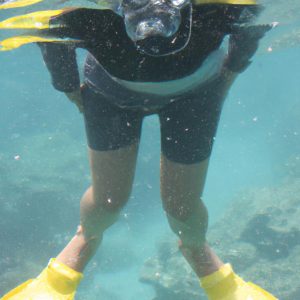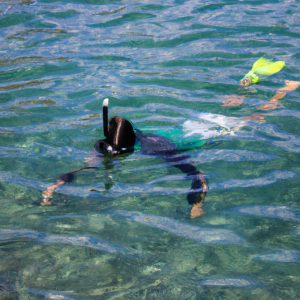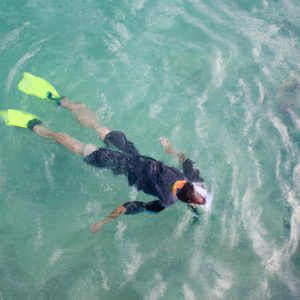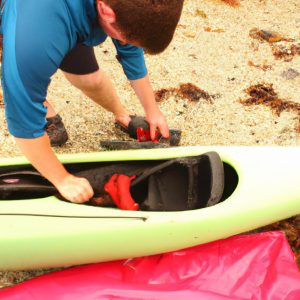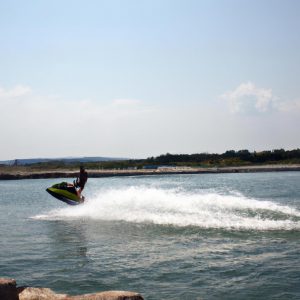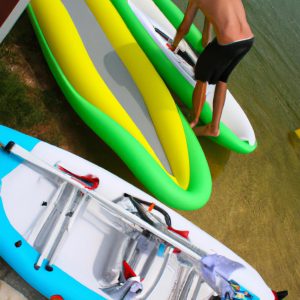Water Sports: Snorkeling Techniques
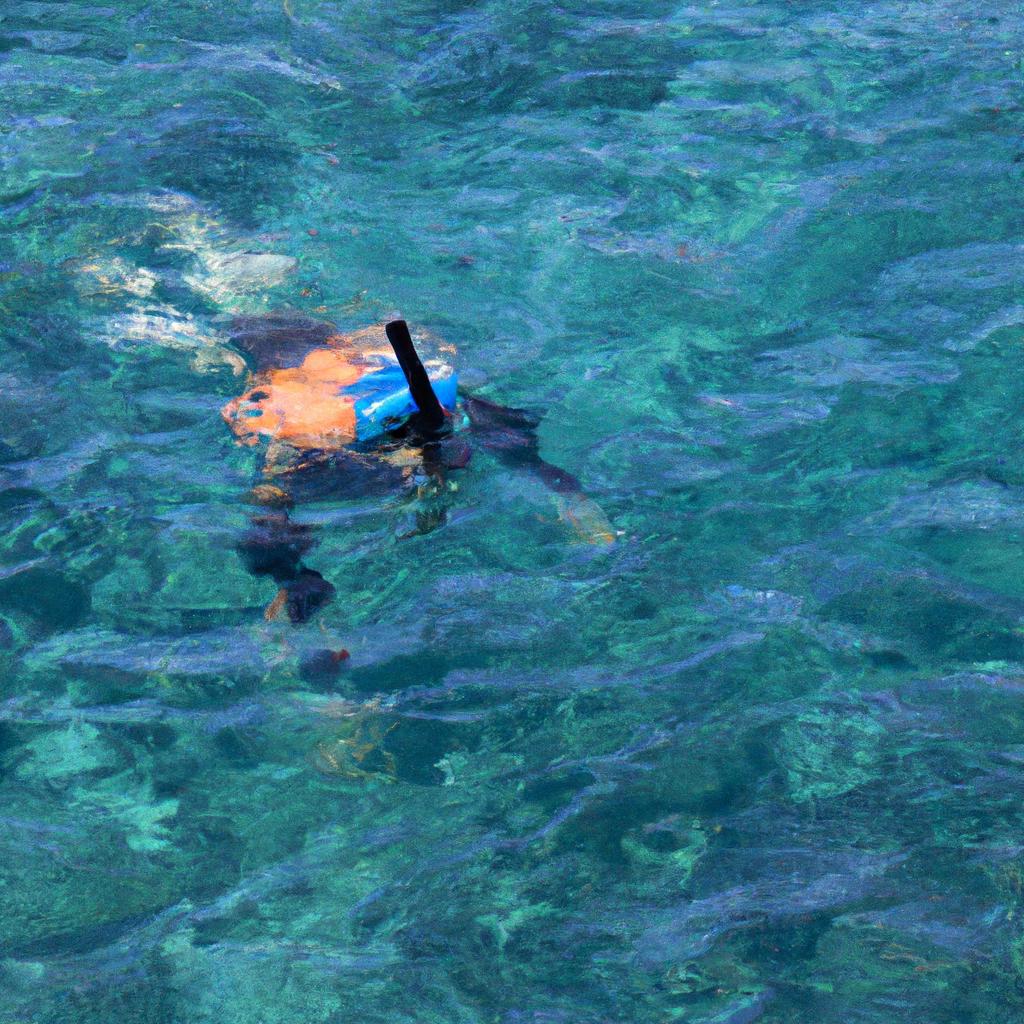
Water sports have gained immense popularity among individuals seeking adventure and relaxation in the aquatic realm. Among these activities, snorkeling stands out as a widely practiced and accessible option for exploring the underwater world. With its minimal equipment requirements and ease of participation, it appeals to beginners as well as experienced enthusiasts alike. For instance, imagine an individual named Sarah who recently embarked on a tropical vacation. Eager to experience the vibrant marine life that lies beneath the surface, Sarah decided to try snorkeling for the first time. However, without proper knowledge of snorkeling techniques, she found herself struggling to make the most of her underwater excursion.
To ensure a fulfilling snorkeling experience like Sarah’s, understanding and implementing effective techniques is crucial. This article aims to provide readers with valuable insights into various aspects of snorkeling techniques. By adhering to these guidelines, individuals can enhance their ability to navigate through water effortlessly while enjoying breathtaking views of coral reefs teeming with colorful fish species. Through a comprehensive exploration of breathing techniques, body positioning strategies, and fin usage methods, this article will equip both novice and seasoned snorkelers with indispensable tools necessary for safe and enjoyable underwater adventures.
Choosing the right snorkel gear
Water sports enthusiasts often find themselves faced with the task of selecting the right snorkel gear. Imagine a scenario where Sarah, an avid traveler and adventure seeker, is planning a trip to a tropical island known for its vibrant marine life. She wants to explore the underwater world through snorkeling but is unsure about how to choose the appropriate equipment.
When it comes to choosing the right snorkel gear, several factors should be considered. Firstly, one must select a mask that fits comfortably on their face and provides a clear field of vision. Ill-fitting masks can lead to discomfort and leakage, hindering the overall experience. Additionally, ensuring that the mask has tempered glass lenses rather than plastic ones enhances durability and prevents fogging.
Next on Sarah’s checklist is finding a suitable snorkel tube. A good quality snorkel tube should have features like a comfortable mouthpiece made from hypoallergenic silicone material and a purge valve to facilitate easy clearing of any water that enters the tube during diving or accidental submersion.
Finally, fins play a crucial role in improving propulsion while swimming underwater. They provide stability and help conserve energy by reducing drag. Choosing fins made from lightweight materials such as rubber or thermoplastic elastomer ensures flexibility without compromising strength.
To summarize these key considerations:
- A well-fitted mask with tempered glass lenses guarantees comfort and clarity.
- Snorkels with comfortable mouthpieces and purge valves aid in efficient breathing.
- Lightweight yet sturdy fins enhance maneuverability underwater.
- Quality construction materials such as silicone, rubber, or thermoplastic elastomer contribute to long-lasting performance.
By making informed choices based on these guidelines, individuals like Sarah can ensure an enjoyable and hassle-free snorkeling experience.
Transitioning into the subsequent section on learning proper breathing techniques: Understanding how to choose appropriate gear sets the foundation for mastering essential skills required in water sports activities like snorkeling—such as learning proper breathing techniques.
Learning proper breathing techniques
Having chosen the right snorkel gear, it is now crucial to learn proper breathing techniques for an enjoyable and safe snorkeling experience. By mastering these techniques, you can optimize your time underwater while ensuring a steady flow of oxygen to support your body’s needs.
Breathing correctly while snorkeling allows you to conserve energy and remain calm in the water. Let’s consider a hypothetical scenario where Sarah, an amateur snorkeler, struggles with her breathing technique during her first snorkeling expedition. As she submerges her face into the water, she inhales sharply through her mouth, causing discomfort and disrupting her overall experience. To avoid such situations, here are some key tips to keep in mind:
- Breathe slowly and deeply: Take slow breaths in through your nose and exhale gently through your mouth. This helps regulate your airflow and reduces the risk of hyperventilation.
- Maintain a relaxed posture: Keep your body loose and free from tension as you float on the surface or swim underwater. Relaxing your muscles promotes better flexibility and control over your breath.
- Practice equalizing pressure: When diving beneath the surface, it is essential to equalize the pressure in your ears by pinching your nostrils shut and gently blowing air out through them. This maneuver prevents discomfort or potential injury.
To further enhance our understanding of effective breathing techniques for snorkeling, let us examine their benefits visually:
- Increased relaxation
- Enhanced focus
- Improved lung capacity
- Reduced anxiety
Visual Representation – Benefits of Proper Breathing Techniques:
| Benefit | Description |
|---|---|
| Increased relaxation | Deep breaths promote a sense of calmness |
| Enhanced focus | Controlled breathing enhances concentration |
| Improved lung capacity | Developing respiratory strength |
| Reduced anxiety | Calming effect on nerves before/during snorkeling |
Incorporating these techniques, you can ensure a more enjoyable and comfortable snorkeling experience. As we transition to the next section on understanding snorkeling safety guidelines, remember that mastering breathing techniques is just one aspect of becoming a proficient snorkeler.
Understanding snorkeling safety guidelines
Transitioning smoothly from the previous section on learning proper breathing techniques, let us now delve into another crucial aspect of snorkeling – understanding snorkeling safety guidelines. By following these guidelines, you can ensure a safe and enjoyable experience while exploring the underwater world.
Before we proceed, consider this hypothetical scenario: Imagine you are snorkeling in a popular reef destination surrounded by vibrant marine life. Suddenly, you find yourself drifting too close to an area with strong currents. Without knowledge of essential safety measures, such as those mentioned below, your exciting adventure could quickly turn perilous.
To help you stay safe during your snorkeling escapades, here are some key safety guidelines to keep in mind:
- Always wear a well-fitting mask and snorkel set.
- Check weather conditions and water visibility before entering the water.
- Never touch or disturb marine creatures or their habitats.
- Be aware of potential hazards like sharp rocks or coral formations.
Table 1 provides further insights into common dangers encountered while snorkeling and how to mitigate them:
| Dangers | Mitigation |
|---|---|
| Strong currents | Avoid swimming against the current; seek assistance if caught |
| Marine animal encounters | Stay calm, avoid sudden movements; give animals space |
| Equipment malfunction | Regularly inspect gear for any damage; carry spare parts |
| Sunburn and dehydration | Wear sunscreen and protective clothing; stay hydrated |
By adhering to these safety guidelines and being mindful of potential dangers listed above (Table 1), you can safeguard yourself and make each snorkeling expedition a memorable one. Remember that responsible exploration not only ensures your personal well-being but also contributes to preserving nature’s delicate balance beneath the waves.
Transitioning smoothly into our next section, let us now turn our attention to mastering the art of clearing a snorkel. Understanding this technique is essential for maintaining unobstructed breathing while underwater.
Mastering the art of clearing a snorkel
Example:
Imagine you are snorkeling in the crystal-clear waters of a tropical paradise. As you glide through the ocean, marveling at the vibrant marine life below, your mind is calm and focused. To fully enjoy this experience, it is essential to master various snorkeling techniques. In this section, we will explore three key techniques that will enhance your underwater adventures.
Buoyancy Control: Mastering buoyancy control is crucial for efficient snorkeling. By properly adjusting your body’s position in the water column, you can effortlessly float on the surface or descend to observe marine life up close. Practice controlled breathing combined with gentle fin movements to maintain neutral buoyancy. Remember to equalize your ears as you descend to avoid discomfort or potential damage.
Streamlining Technique: Streamlining yourself in the water minimizes drag and maximizes efficiency during snorkeling expeditions. Keep your arms alongside your body and tuck them slightly behind you while swimming with fins. This technique reduces resistance and allows for smoother movement through the water. Additionally, ensure that all equipment, such as masks and snorkels, fits snugly without any loose straps or leaks.
Clearing Water from Your Mask: It is common for water to enter your mask while snorkeling, which can obstruct vision and cause discomfort. Learning how to clear water from your mask efficiently is essential. Here’s a step-by-step guide:
- Tilt your head backward slightly.
- Press firmly against the top edge of the mask frame using one hand.
- Exhale forcefully through your nose while simultaneously lifting the bottom portion of the mask away from your face.
- Allow any trapped water to drain out before resealing the mask against your face by releasing pressure on the top edge.
Remember these essential techniques as they form the foundation of successful snorkeling experiences.
- Feel a sense of tranquility as you effortlessly float on the surface of the water.
- Experience awe and wonder while observing diverse marine life up close.
- Enjoy a sense of freedom as you explore underwater landscapes with ease.
- Cultivate a deeper connection to nature through immersive snorkeling adventures.
Emotional Table:
| Technique | Benefits |
|---|---|
| Buoyancy Control | Effortless floating and descending |
| Streamlining | Reduced drag for smoother movement |
| Clearing Water | Improved visibility and comfort |
By mastering these essential snorkeling techniques, you will be ready to embark on your next adventure: exploring different snorkeling locations. So let’s dive in!
Exploring different snorkeling locations
Clearing your snorkel is an essential skill to ensure proper breathing while exploring the underwater world. By effectively removing any water that enters your snorkel, you can maintain a clear airway and continue enjoying your snorkeling experience. Let’s delve deeper into some techniques for mastering this crucial aspect of snorkeling.
Imagine yourself diving beneath the surface, encountering a vibrant coral reef teeming with marine life. As you swim, you suddenly feel water entering your snorkel. In this situation, it is vital to remain calm and quickly employ one of these effective methods for clearing your snorkel:
- Blast Method: With this technique, forcefully exhale through the mouthpiece, causing a powerful burst of air to expel any water from the tube.
- Purge Valve Method: Many modern snorkels are equipped with purge valves at their base. To use this method, simply exhale gently into the valve, allowing it to release any trapped water.
- Head Tilt Technique: Another option involves tilting your head backward slightly while simultaneously blowing out through your nose or pursed lips, forcing the water out of the top of the snorkel.
- Snorkel Splash Method: This technique may require more practice but is effective nonetheless. Submerge your head entirely in the water while keeping pressure on the top end of your snorkel; then resurface swiftly and sharply blow out to eliminate any water inside.
To fully grasp these techniques and improve as a snorkeler, consider practicing each method in shallow waters before venturing into deeper areas where maintaining control becomes even more critical.
Now that we have covered how to master clearing a snorkel let’s move on to our next topic – exploring different locations ideal for incredible snorkeling experiences.
Tips for spotting marine life underwater
In order to make the most of your time spent underwater while snorkeling, it is crucial to develop the skill of spotting marine life. By honing your observation abilities, you can enhance your overall snorkeling experience and gain a deeper appreciation for the diverse ecosystem beneath the waves. So, how can you improve your chances of encountering fascinating sea creatures? Stay tuned to find out!
Tips for spotting marine life underwater
Exploring different snorkeling locations can provide a unique experience with varying underwater landscapes and marine life. One such location is the Great Barrier Reef in Australia, known for its vibrant coral reefs and diverse array of species. Imagine yourself gliding through crystal-clear waters, surrounded by colorful fish darting among intricate coral formations. This captivating scenery is just one example of what awaits snorkelers at this iconic destination.
To enhance your snorkeling adventures, here are some tips for spotting marine life underwater:
- Take it slow: Moving slowly and calmly allows you to blend into the environment and increases your chances of encountering marine creatures without startling them.
- Look closely: Pay attention to small details like movement or subtle changes in coloration that may indicate the presence of hidden sea creatures.
- Observe patterns: Marine animals often follow specific patterns or routines. By understanding these behaviors, you can predict where certain species might be found during different times of the day or tide cycles.
- Stay patient: Some marine species are more elusive than others. Patience is key when waiting for a shy octopus to reveal itself or observing a camouflaged seahorse blending seamlessly into its surroundings.
In addition to these tips, having knowledge about various marine organisms can greatly enrich your snorkeling experience. Consider the following table showcasing three fascinating species commonly encountered while snorkeling:
| Species | Habitat | Notable Features |
|---|---|---|
| Clownfish | Coral reefs | Vibrant orange and white body |
| Green Sea Turtle | Coastal areas | Distinctive patterned shell |
| Manta Ray | Open ocean | Wingspan up to 7 meters |
By familiarizing yourself with the characteristics of these species and their preferred habitats, you increase your chances of recognizing them during your snorkeling excursions.
In summary, exploring different snorkeling locations offers an opportunity to immerse yourself in the wonders of marine life. Whether it’s admiring the vibrant coral reefs of the Great Barrier Reef or encountering unique species like clownfish, green sea turtles, and manta rays, snorkeling provides a gateway to an underwater world filled with beauty and discovery. Remember to employ the aforementioned tips and keep your eyes peeled for these fascinating creatures as you embark on your next snorkeling adventure.

